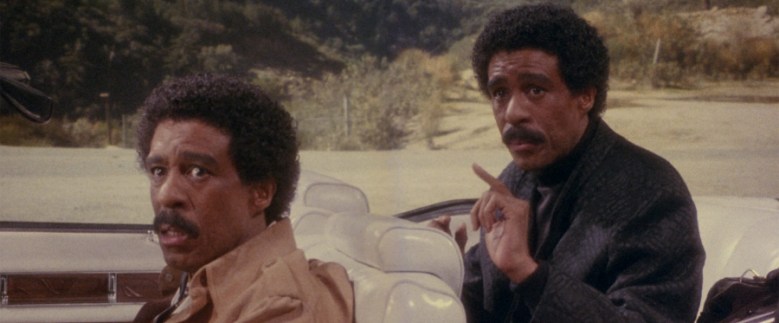In his 1982 stand-up special “Richard Pryor: Live on the Sunset Strip,” the comedian addressed stories of an accident he had with a pithy joke. In 1980, it had been reported that Pryor accidentally set himself on fire while freebasing cocaine. On stage, he referenced the many people who made light of the incident by lighting a match and dramatically waving it around. “What’s that? Richard Pryor running down the street!” He himself followed suit, turning the entire affair into an elaborate, comedic explanation for how he came to be ablaze. But in 1986, he would confess during an interview with Barbara Walters that it was, in fact, a suicide attempt.
Between that special and that interview, Pryor co-wrote, directed, and starred in “Jo Jo Dancer, Your Life is Calling,” a semi-autobiographical dramatization of the fire and a raw rumination of the life that led to it. The film opens with Jo Jo Dancer (Pryor in all but name) crawling around on the floor looking for any straggler rock remnants he has yet to smoke. He calls his old dealer to score, but when the dealer reminds him that he’s supposed to be clean, he pretends the call was to invite him to a party that does not in fact exist. After, there’s a powerful shot where he catches his reflection in the mirror. He sees himself, a grown man of noticeable wealth scrounging on the carpet on all floors like an animal for a taste of what he’s just pretended he no longer needs. The realization seems to spark something profound until he does, in fact, find an unsmoked rock.
From there, we immediately cut to an intense sequence of Dancer in a hospital being treated for third-degree burns all over his body. It presents all the detailed realism of an “ER” episode, with all the hospital jargon and hurried line deliveries necessary to make it clear Dancer might not make it. At this point, his inner soul, also played by Pryor, separates itself from his charred corporeal form and begins a walk through Dancer’s past. The journey stretches from his childhood spent growing up in a brothel to his escape from his abusive father to his sojourn to a nearby city to pursue comedy, all the way through to the suffocating aftereffects of his success.
The approach is a fascinating one. We’ve experienced tons of media wherein a protagonist is faced with his past, guided by some spiritual figure, usually watching from afar, unable to interact. But Pryor stages this journey with more elasticity. As the physical embodiment of his own soul, he plainly interacts with people and situations from his past, often giving insight or sincerity from them he never could have gotten or processed at the time. It’s an ongoing conversation between this wounded, free-moving Dancer, who doesn’t understand how it all went wrong, questioning and cajoling the bedridden Dancer.
There’s one particular sequence where Dancer’s mother begs him for forgiveness while she’s initiating sex with one of her clients, and Dancer turns away to look through the doorway at himself still in the hospital bed. Through the entire interaction leading up to this moment, the ambient noises of the hospital, the beeps and hums of the machines keeping Dancer alive, permeate into this living flashback. It’s stirring stuff.
It’s clear to see why the movie received such mixed reviews at the time. Placing it within the context of Pryor’s comedic filmography, it is a much tougher watch in tone.
But it’s clear to see why the movie received such mixed reviews at the time. Placing it within the context of Pryor’s comedic filmography, it is a much tougher watch in tone. It’s still hilarious, but every single bit of humor is still tethered to the pain that inspired it. When Dancer makes it to a new city but is too broke to survive, we watch his stomach grumble on a bus so loudly it feels like a cartoon. It’s framed as a sitcom laugh trigger and a knowing depiction of brokeness, all in the same beat. Even when we see extended pieces of Dancer’s stand-up, it’s him joking about being thrown up on as a baby, or later, addressing the film’s themes so head on, we begin to wonder if this is stand-up or if Dancer has really died and is simply addressing it from the afterlife.
The film is not without its foibles and false notes. There’s a montage of Dancer coming into his own as a performer set to Marvin Gaye’s “What’s Going On?” that feels so forced and strange relative to how honest and real the rest of the film reads. Also, when the film delves into his interracial relationships, he admonishes his white lover about her unearned radicalism “You read Malcolm X. I know Malcolm,” he tells her. However, the scene rings a little hollow by not addressing why so many white people surround him at this juncture in his life, to begin with.
For decades, there’s been a pipeline for funny comics to morph into serious filmmakers (Woody Allen, Louis C.K., Aziz Ansari) or serious pundits (Jon Stewart, Bill Maher, countless others, unfortunately), but Pryor’s attempt at real artistry feels like it was rejected for its rawness. Few filmmakers in this vein bear themselves to this degree, often opting instead to stick to slice-of-life romantic dramas.
Years later, audiences were more welcoming to Chris Rock’s forays into film directing, like “Top Five” and “I Think I Love My Wife,” mainly because the finished results weren’t that far off from what we expect from his stand-up and the films he’s made for others. But to this day, “Jo Jo Dancer” remains a unique cinematic proposition, the filmic version of watching a man poke at a raw, exposed nerve for your benefit as much as his own.
“Jo Jo Dancer, Your Life is Calling” is currently streaming on Tubi and The Roku Channel.

